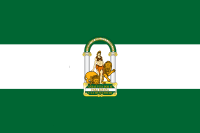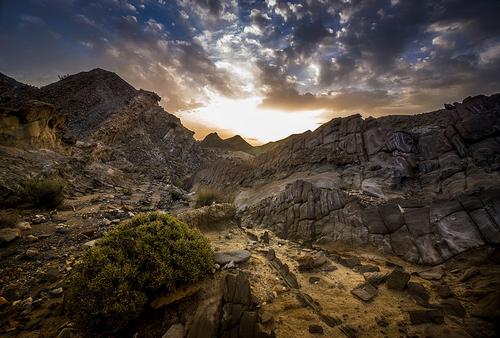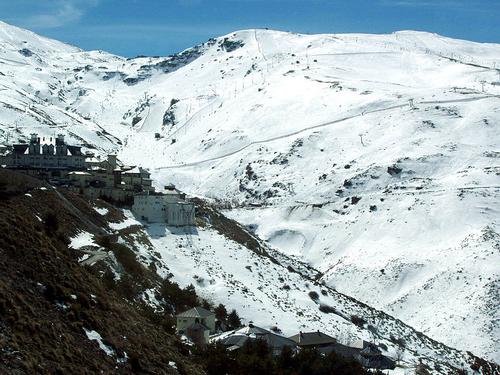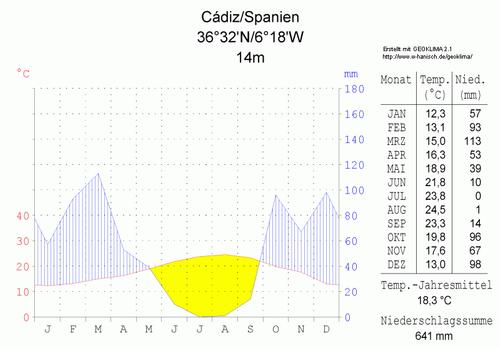ANDALUSIA
Climate and Weather

Climate and Weather

Popular destinations SPAIN
| Andalusia | Catalonia | Costa blanca |
| Costa brava | Costa del sol | El hierro |
| Formentera | Fuerteventura | Gran canaria |
| Ibiza | La gomera | La palma |
| Lanzarote | Mallorca | Menorca |
| Tenerife |
Climate and Weather
 Almeria DesertPhoto: Colin C Wheeler CC 3.0 Spain no changes made
Almeria DesertPhoto: Colin C Wheeler CC 3.0 Spain no changes made
Andalusia generally has a Mediterranean climate with warm, dry summers and mild, rainy winters. Due to the vastness of Andalusia, the presence of various mountain ranges and a coastal region bordering the Mediterranean and the Atlantic Ocean, there are still considerable differences to be noted. For example, the popular Costa del Sol is located on the sheltered Mediterranean Sea where it often blows a wind, on the Costa de la Luz, located on the Atlantic Ocean, it can sometimes be stormy and the temperature in the summer is tempered by the wind and cools down considerably in the winter months. Tarifa is also called the wind and kite surfing capital of Europe because of its constant presence. The Alpujarras, a well-known hiking area in the Sierra Nevada, is again doable in summer due to the high elevation.
Andalusia has the hottest and driest summers in Spain, but weather systems in the west ensure that it is relatively wet in winter. Some areas even receive quite a lot of rainfall, so much so that in the whole of Andalusia there is more rainfall on average than the average in all of Spain. One of the 'wettest' cities is Western Andalusian Grazalema in the Sierra de Grazalema, with an average of 2,153 mm of rainfall per year (in 1963 this area almost drowned in 4,346 mm of rainfall). Although this is an extreme case, most regions of the provinces of Cadiz and Huelva, and the Sierra de Cazorla receive more than 1000 mm of rainfall per year, double that of the capital Madrid. In the interior of the provinces of Jaén, Córdoba and Seville 500-700 mm falls per year, even further to the east it becomes increasingly drier as the Atlantic rain clouds lose more and more moisture along the way. This ends in the desert-like landscapes of Almería, and then with the Cabo de Gata, the driest region of the Iberian Peninsula (and probably all of Europe) where hardly more than 150 mm of rainfall per year falls. as cold as in the Sierra Nevada, some peaks of which are covered with snow all year round and you can ski until May. Good weather is almost always expected on the Costa del Sol, but nothing could be further from the truth. In winter and spring it can even be very changeable and it can rain for days on end.
 Snow Sierra Nevada in AndalusiaPhoto: Emilio J. Rodríguez Posada CC 3.0 Unported no changes made
Snow Sierra Nevada in AndalusiaPhoto: Emilio J. Rodríguez Posada CC 3.0 Unported no changes made
IIn much of Andalusia, the sun shines more than 300 days a year. Of all provincial capitals, Almería and Seville have the highest average daily temperatures with 18.6 °C and 18.7° C respectively, followed by Huelva with 18.3° C and Cadiz with 18.2°C. The 'coolest' capital is Granada at the foot of the Sierra de Cazorla with 15.1°C. Some parts of the province of Almería compete with the south of the province of Alicante for the warmest place in Spain; Los Gallardos has a good chance with an average temperature of 20.1°C. The average temperature for the whole of Andalusia is 16°C. The coldest month is January with average temperatures of 12.5°C in Málaga and 6.4°C in Granada; the hottest month is August with the city of Écija in the province of Seville as the hotspot with 28.5°C. Summer temperatures regularly reach over 40°C and in cities such as Seville and Córdoba it is almost impossible to bear the heat during the day, with temperatures reaching, fortunately exceptionally, up to 46°C. In a city like Málaga, the temperature can rise to over 40°C in summer when the terral starts blowing, a föhn wind that blows from north to south.
 Climate table CádizPhoto: Hedwig in Washington CC-BY 2.5 no changes made
Climate table CádizPhoto: Hedwig in Washington CC-BY 2.5 no changes made
| Jan. | Feb. | March | April | May | June | July | Aug. | Sept. | Oct. | nov. | dec. | |
| Almería max. | 16 | 16 | 18 | 20 | 22 | 26 | 29 | 29 | 27 | 23 | 19 | 17 |
| Almería min. | 8 | 8 | 10 | 12 | 15 | 18 | 21 | 22 | 20 | 16 | 12 | 9 |
| Cádiz max. | 15 | 16 | 18 | 21 | 23 | 27 | 29 | 30 | 27 | 23 | 19 | 16 |
| Cádiz min. | 8 | 9 | 11 | 12 | 14 | 18 | 20 | 20 | 19 | 16 | 12 | 9 |
| Córdoba max. | 14 | 16 | 19 | 23 | 26 | 32 | 36 | 36 | 31 | 24 | 19 | 14 |
| Córdoba min. | 4 | 5 | 8 | 10 | 13 | 17 | 19 | 20 | 17 | 13 | 8 | 5 |
| Granada max. | 12 | 14 | 18 | 20 | 24 | 30 | 34 | 34 | 29 | 22 | 17 | 12 |
| Granada min. | 1 | 2 | 5 | 7 | 9 | 14 | 17 | 17 | 14 | 9 | 5 | 2 |
| Huelva max. | 16 | 18 | 20 | 22 | 25 | 29 | 32 | 32 | 29 | 25 | 21 | 17 |
| Huelva min. | 6 | 7 | 9 | 11 | 13 | 16 | 18 | 18 | 17 | 14 | 10 | 7 |
| Ién max. | 12 | 14 | 17 | 20 | 24 | 30 | 34 | 34 | 29 | 22 | 16 | 12 |
| Jaén min. | 5 | 5 | 8 | 10 | 13 | 17 | 21 | 21 | 18 | 13 | 9 | 5 |
| Málaga max. | 16 | 17 | 19 | 21 | 24 | 28 | 30 | 30 | 28 | 24 | 20 | 17 |
| Málaga min. | 8 | 8 | 10 | 11 | 14 | 17 | 20 | 20 | 18 | 15 | 12 | 9 |
| Seville max. | 15 | 17 | 20 | 23 | 26 | 32 | 36 | 36 | 32 | 26 | 20 | 16 |
| Sevilla min. | 6 | 6 | 9 | 11 | 13 | 17 | 20 | 20 | 18 | 14 | 10 | 7 |
Sources
Andalucía
Lonely Planet
Andalusië
Lannoo
Baird, David / Sevilla & Andalusië
Van Reemst
BBC - Country Profiles
CIA - World Factbook
Dahms, Martin / Andalusië
Van Reemst
Hannigan, Des / Andalusië
Kosmos
Kennedy, Jeffrey / Andalusië & Costa del Sol
Van Reemst
O'Bryan, Linda / Andalusië
Uitgeverij J.H. Gottmer/H.J.W. Becht BV
Wikipedia
Copyright: Team The World of Info